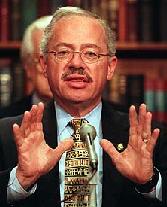The Internet and the Resistance to War on Iraq Grassfire
This Sunday I watched a very long and depressing line of speakers from the United States Bureau of Making Shit Up. James Woolsey (former head of the CIA and freelance war-hawk) speculated wildly and baselessly about possible connections between Iraq and al-Qaeda. An anonymous terrorism expert
moved beyond baseless allegation into nothing more than vague insinuations–he was particularly a fan of the claim that the Beltway sniper is actually an al-Qaeda operative, in spite of the complete lack of any basis whatsoever for asserting this to be probable, let alone true. Bill Kristol then got on and talked for a while about the need to bomb the world and starve North Korea, and practically accusing Tom Daschle of treason for daring to question the President’s authoritarian and secretive attitude towards Congress and the American people on foreign policy issues.
Well, OK. I expect this shit from Fox News. But while they drone on, an astounding grassfire movement against the war is welling up. The latest development is something that should get the attention of every Right-wing Bomb the World
Republican, every spineless amoral Democrat, and the few progressives and genuine Lefties that remain in DC. Over the past week, MoveOn PAC‘s Reward the Heroes
drive has raised over 1 million dollars for the campaigns of Congresspeople and Senators who opposed the President’s resolution for war against Iraq. Over $1,000,000 in a week! And we’re not talking about Republican or DLC-style contributions from millionaires here. We’re talking about over 37,000 individual contributions. An average of about $27 per contribution (I gave two contributions of $25, personally). If the DC cognoscenti start taking notice, this could be a very big deal. Money talks in DC, and right now, the people are screaming at the top of their lungs.
Of course, this campaign–like all campaigns–has its limitations. Among them:
It’s depressing that this action will talk much louder than the hundreds of thousands of calls, letters, and e-mails against war on Iraq that were sent out over the past several weeks. The pre-eminence of PAC money-laundering in politics is not a trend that I really want to see strengthened, although I’m willing to work to get through to Congress by pretty much any just means necessary right now.
The campaign is primarily focusing on funnelling money to support incumbent Democrats who voted against the war. With the exception of that lying goat Paul Wellstone, I don’t have any objection to supporting those who have taken a stand against war. But I’d also like to see a lot more invested in getting new blood into Congress, not just giving established Lefty Democrats a political sinecure.
Maintaining a Congress which is independent of the grip of the far Right is important, but we have to do a lot more than that to keep the country from going to hell in a handbasket. Slowing the bleeding will only do so much.
MoveOn, for all of its virtues in moving Internet activism out into the offline world, makes no particular efforts to reach out to people other than those who can receive their e-mail alerts or access their website.
Again, the power of the Internet as an organizing medium is simply astounding, and we have to take very seriously how we are going to make the best use of it. The MoveOn PAC campaign is one very important way to put a lot of energy into grassroots campaigns, but we have to see this as only the start, and improve from here.
So what do we need to do?
We need to follow up this campaign with more campaigns that move beyond online voting and make concrete actions. Contributing to campaigns where necessary, I guess, but also building up funding reserves for other purposes–organizing spaces, grassroots organizing (including workplace unionizing), and all the other infrastructure of a successful, anti-vanguardist resistance to the Right-wing Powers that Be. MoveOn PAC’s campaign is a brilliant example of a dynamic, exciting, creative way of standing up against the flow in DC and making them listen. Let’s come up with more ideas.
We also need to talk about ways to allow online campaigns to reach out to people who don’t spend a lot of time on the Internet–people who tend to be older, poorer, racial minorities, etc. The Right doesn’t care: every CEO and arm-chair warhawk columnist has e-mail, Web access, and all the money the Right-wing foundations have to offer. But we have to work with people, not just dollars, and we have to think about building a mass movement. Otherwise, as Martin Striz pointed out in this space:
Unfortunately, this nascent form of democratic political transformation is only relevant to those who have an Internet connection, and the unfortunate divide between the haves and have-nots will continue to plague us.
So what can we do to pull that off? Well, simply focusing on campaigns that move offline and into the world of street protests, organizing spaces, letters to the editor, and other things in the meatspace will help. But let’s start thinking about other ways to convert Internet organizing into a galvanizing force for everyone. I don’t have many more ideas than anyone else on this–I’ve lobbied for printable posters and flyers to be available from all websites that advertise an offline political event, and I think that working on developing phone trees that spread from online to offline contacts would also be a really cool idea. But I’m a neophyte like everyone else and I’m really interested in hearing some creative ideas about where we can go from here.
In the meantime, toss a few bucks to the [MoveOn PAC][] Reward the Heroes
campaign, and help make our voice heard in support of pro-peace candidates.
